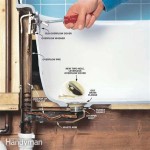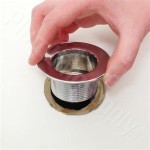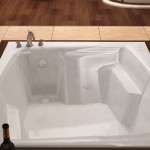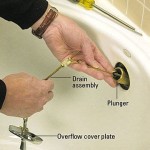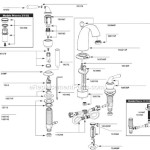Standard Bathtub Size Width: A Comprehensive Guide
The bathtub is a staple in many bathrooms, offering a space for relaxation, hygiene, and therapeutic soaks. Selecting the right bathtub involves considering various factors, including bathroom size, personal preferences, and accessibility needs. One of the crucial dimensions to consider is the width of the bathtub, which significantly impacts comfort, usability, and overall bathroom aesthetics. This article provides a comprehensive guide to standard bathtub width sizes, exploring their implications and helping individuals make informed decisions when choosing the ideal tub for their needs.
Understanding the dimensions of a bathtub is crucial before making a purchase. The width, length, and height all contribute to the bathing experience. Bathtubs are typically measured in inches, and these measurements often refer to the exterior dimensions of the tub. The interior dimensions, the actual space available for bathing, will be smaller due to the tub's wall thickness and design.
The width of a bathtub is the measurement from one side of the tub to the other. It's typically the shorter dimension compared to the length. The width significantly impacts how comfortably a person can recline or sit in the tub, and it also affects the amount of water the tub can hold. Variations in width can accommodate different body types and preferences.
Standard Bathtub Width Dimensions
While "standard" can be a broad term, referring to the most commonly encountered sizes, typical bathtub widths tend to fall within a range. Understanding this range allows homeowners and contractors to plan effectively during bathroom renovations or new construction projects.
The most common standard bathtub width is 30 inches. This width is widely available and often considered the baseline for many bathtub designs. It's suitable for average-sized individuals and fits well in many standard-sized bathrooms. However, some modern designs are trending toward larger sizes, blurring the lines of what is considered truly standard.
Another commonly encountered width is 32 inches. This slightly wider option provides a bit more space for bathing and can accommodate larger individuals more comfortably. The difference of two inches might seem minimal, but it can have a noticeable impact on the overall bathing experience. This width often appears in newer homes and renovated bathrooms where space allows for a larger fixture.
Bathtub widths can extend beyond these standard sizes, ranging up to 36 inches or even wider in some luxury or specialty models. These wider bathtubs often offer enhanced comfort and are intended for individuals who desire a more spacious bathing experience. They are also more likely to be featured in larger bathrooms designed for relaxation and spa-like environments.
Smaller bathtubs, often referred to as soaking tubs or Japanese tubs, can have widths less than 30 inches, sometimes as narrow as 27 inches. These are designed for deeper soaking in a more upright position and are suitable for smaller bathrooms or individuals who prefer a different bathing style. They prioritize depth over length and width.
Factors Influencing Bathtub Width Selection
Choosing the appropriate bathtub width involves carefully considering several factors, including bathroom size, user needs, and design preferences. A thorough evaluation of these factors helps ensure that the selected bathtub fits comfortably in the available space and meets the specific requirements of the users.
The size of the bathroom is a primary constraint when selecting a bathtub. Smaller bathrooms may only accommodate narrower bathtubs, while larger bathrooms can accommodate wider models. It's essential to measure the available space accurately and account for clearances around the tub for comfortable movement. Consider door swing, toilet placement, and vanity dimensions to determine the optimal bathtub dimensions.
User needs also play a crucial role in determining the appropriate bathtub width. Individuals with mobility issues may benefit from a wider bathtub that provides ample space for maneuvering. Larger individuals may also require a wider bathtub for comfortable bathing. Consider the specific needs of all users to ensure that the selected bathtub is accessible and comfortable for everyone.
Design preferences can also influence the choice of bathtub width. Modern bathrooms often feature wider bathtubs as focal points, creating a spa-like atmosphere. Traditional bathrooms may opt for narrower bathtubs that blend seamlessly with the overall design. The bathtub's width should complement the overall aesthetic of the bathroom and enhance its visual appeal.
Bathtub material can also indirectly impact width selection. Some materials, such as cast iron, may require thicker walls, potentially reducing the interior bathing space for a given exterior width. Acrylic tubs tend to be lighter and can sometimes allow for thinner walls, maximizing interior space.
Implications of Bathtub Width Choices
The width of the bathtub has significant implications for comfort, water usage, and installation considerations. Understanding these implications helps individuals make informed decisions and avoid potential issues during and after installation.
A wider bathtub generally offers enhanced comfort, providing more space to recline and move around. This is particularly important for larger individuals or those who enjoy long, relaxing soaks. However, an excessively wide bathtub may be uncomfortable for smaller individuals, making it difficult to reach the sides of the tub comfortably.
Wider bathtubs typically require more water to fill, which can increase water consumption and energy costs if the water heater needs to work harder. Consider the environmental and financial implications of choosing a wider bathtub and opt for water-saving features, such as low-flow showerheads, to mitigate these effects.
The installation of a wider bathtub may require more extensive plumbing modifications and structural support. Ensure that the bathroom floor can support the weight of the filled bathtub and that the plumbing connections are properly configured. Consult with a qualified plumber or contractor to assess the installation requirements and ensure that the bathtub is installed safely and correctly.
Accessibility is another crucial point. Consider features like grab bars, slip-resistant surfaces, and walk-in options, particularly when planning for elderly or disabled users. These modifications often necessitate a certain bathtub width to ensure sufficient space and safety.
The shape of the bathtub, while related to both length and width, also plays a role. Oval bathtubs, for example, might offer a wider area in the middle but taper at the ends, influencing the effective width where a person would actually be seated or reclining.
The depth of the tub, coupled with the width, ultimately determines the bathing experience. A wider tub that isn't very deep might not provide the immersive soak desired, whereas a narrower but deep tub could be more satisfying for some users. These dimensions should be considered together for a holistic view.
The location of the drain can also be affected by the width. A center drain might be preferred for a symmetrical look, but an end drain might be more practical for certain bathroom layouts. The choice can also impact cleaning and maintenance.
Ultimately, selecting the correct bathtub width is a balance between personal comfort, available space, budget, and long-term considerations. Careful planning and professional advice can assist in navigating these factors to guarantee the best result for any specific bathroom installation.
:max_bytes(150000):strip_icc()/SPR-bathtub-sizes-reference-guide-1821342-52e8193f6ecd479d95ef77ab3954d1ea.png?strip=all)
Standard Bathtub Sizes In Feet Guide To Common Tubs

Standard Bathtub Sizes Which Is Best For Your Bathroom
How To Measure A Bathtub Standard Tub Sizes Measuring Guide Vevano

Standard Bathtub Dimensions And Sizes By Type 2024 Guide

Standard Bathtub Dimensions And Sizes By Type 2024 Guide

Are Bathtub Sizes The Rough In Size Or Tub Interior Home Improvement Stack Exchange

Pin Page

Aspirations 60 X 30 Inch Integral Apron Bathtub With Left Hand Drain

Types Of Bathtubs The Home Depot

Standard Bathtub Dimensions Types Of Foyr


